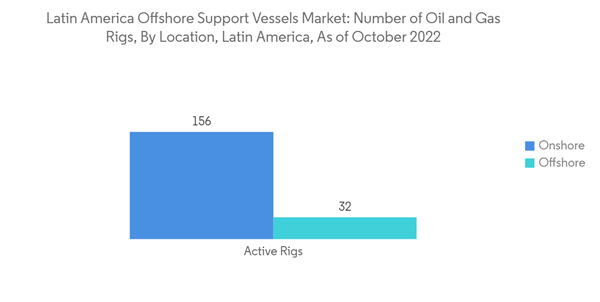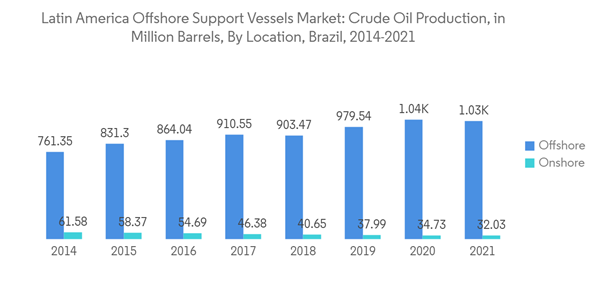The market was negatively impacted by COVID-19. Presently the market has now reached pre-pandemic levels.
Over the medium term, factors like increased offshore oil and gas exploration and wind farm projects in the Atlantic Ocean are likely to drive the market.
On the other hand, stringent regulations by the governments and heavy fine for any issue related to the environment is likely to restrain market growth.
Nevertheless, increasing exploration and development activities in the recently found deep-water basins, such as Santos Basin and Campos Basin, are likely to create many opportunities for the Latin American offshore support market in the future.
Due to its highest number of deep-water activities in the Atlantic Ocean, Brazil is expected to see significant market growth during the forecast period.
Latin America Offshore Support Vessels Market Trends
Platform Supply Vessels (PSVs) Segment to Dominate the Market
Latina America is home to some of the world's largest countries in terms of proven oil and gas reserves. The region also hosts one of the largest offshore oil and gas markets around the globe. Brazil, Venezuela, Mexico, Argentina, and Colombia are the major countries in the region's oil and gas industry.Offshore oil and gas projects in Latina America have lower breakeven prices and competitive payback times compared to similar projects worldwide, making them more resilient in the current turbulent times. Around 30 offshore oil and gas projects are expected to start across the region by 2023, which requires a cumulative greenfield investment of around USD 50 billion. These projects are operated by a mix of national oil companies (NOCs) and major independent companies.
Platform Supply Vessels (PSVs) are the offshore vessels used for transferring equipment, crew, and other goods to the offshore drilling platform. In 2014, after a decrease in oil prices, the offshore support vessel market slowed down, but as the oil prices began to rise, the offshore support vessel market also gained its pace. As of October 2022, there were 156 onshore rigs in the region, with a further 32 rigs located offshore.
Guyana is expected to be a new entrant this decade in the list of major offshore producing regions due to the discovery of more than 8 billion BOE (barrel of oil equivalent) reserves in the ExxonMobil-operated Stabroek block. Close to 4 billion BOE of reserves are expected to be sanctioned by 2025, which will require investments in USD 30 billion and contribute more than 900,000 barrels of oil per day at peak production.
In July 2022, ExxonMobil and its partners announced two new oil discoveries in the Seabob-1 and Kiru-Kiru-1 wells, located in the Stabroek block offshore Guyana. As a result of these discoveries in the southeast of Liza and Payara developments, the previously discovered recoverable resources at the Stabroek block have been increased to approximately 11 billion barrel of oil equivalent.
In October 2022, Mexico's oil regulator approved the revamped plan presented by Pemex for developing the once-abandoned Lakach deepwater natural gas project.
The above-mentioned project's exploration and development phase will require huge amounts of equipment that can be delivered by platform supply vessels (PSVs).
Hence, the above points indicate that PSVs are expected to dominate the Latin American offshore support vessels market during the forecast period.
Brazil to Dominate the Market
The deepwater and ultra-deep-water activities directly influence the offshore support vessels market. After oil prices dropped in 2014, many countries shifted toward onshore projects. Still, it turned out that the return investment period of onshore projects is 10 to 15 years. So, Brazil started deepwater and ultra-deep-water explorations, which are more profitable and have a return investment period of 5 to 6 years.According to the National Agency of Petroleum, Natural Gas, and Biofuels (ANP), in 2021, out of the total crude oil production in the country, 97% came from offshore, and only 3 % came from onshore. The total crude oil production in the country was 1060.37 million barrel. Further upcoming projects in the deepwater are likely to increase Brazil's share in the Latin American offshore support vessels market.
In 2021, Brazil was the ninth-largest producer of oil and gas in the world, the largest producer in South America, and the eighth-largest oil product consumer in the world. Most of the oil and gas are produced offshore.
As of June 2022, around seven active rigs were operating in the offshore areas and three active rigs in the onshore areas of the country. As of 2021, floating assets such as floating production storage and offloading (FPSO), drillships, semi-submersibles, and Floating Storage and Offloading (FSO) accounted for more than 80% of the active offshore platforms in the country. This, in turn, indicates the dominance of offshore floating assets in Brazil's upstream oil and gas industry.
Brazil is expected to play a major role in the offshore oil and gas industry's recovery from a tumultuous 2020, especially in the floating production market. The country is expected to deploy around 18 FPSOs by 2025.
In May 2022, Singapore's Keppel Shipyard submitted the best bids in a Petrobras tender for the engineering, procurement, and construction (EPC) contracts for two FPSOs planned for Brazil's Buzios field. Keppel offered USD 2.98 billion each in lot A and lot B, beating the proposals of Sembcorp Marine, which offered USD 3.66 billion and USD 3.73 billion. Four other prospective bidders declined to submit proposals. Moreover, the FPSOs involved are P-80 and P-82, scheduled to begin operations in 2026 in the Santos basin pre-salt asset.
Petrobras plans to invest around USD 68 billion from 2022 to 2026. Of this total investment, 84% will be allocated to oil and natural gas exploration and production (E&P). Of the total E&P CAPEX (USD 57 billion), around 67% will be allocated to pre-salt assets. This indicates that the upstream oil and gas sector, especially Brazil's offshore oil and gas assets, is expected to witness significant investment during the forecast period. Therefore, factors such as plans to develop offshore oil and gas blocks, particularly in the presalt basins, are expected to drive the offshore support vessels market in Brazil during the forecast period.
Therefore, owing to the above points, Brazil, with most of the activities in the offshore deepwater, is likely to see significant growth in the Latin American offshore support vessels market during the forecast period.
Latin America Offshore Support Vessels Market Competitor Analysis
The Latin American offshore support vessels market is moderately consolidated. Some of the major players in the market include Edison Chouest Offshore, Tidewater Inc., GulfMark Offshore, Inc., SEACOR Marine Holdings Inc., and Bourbon Corp, among others.Additional benefits of purchasing the report:
- The market estimate (ME) sheet in Excel format
- 3 months of analyst support
This product will be delivered within 2 business days.
Table of Contents
Methodology

LOADING...










